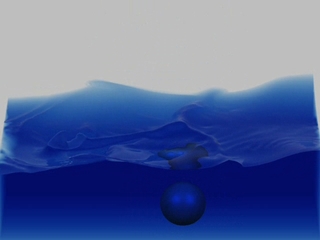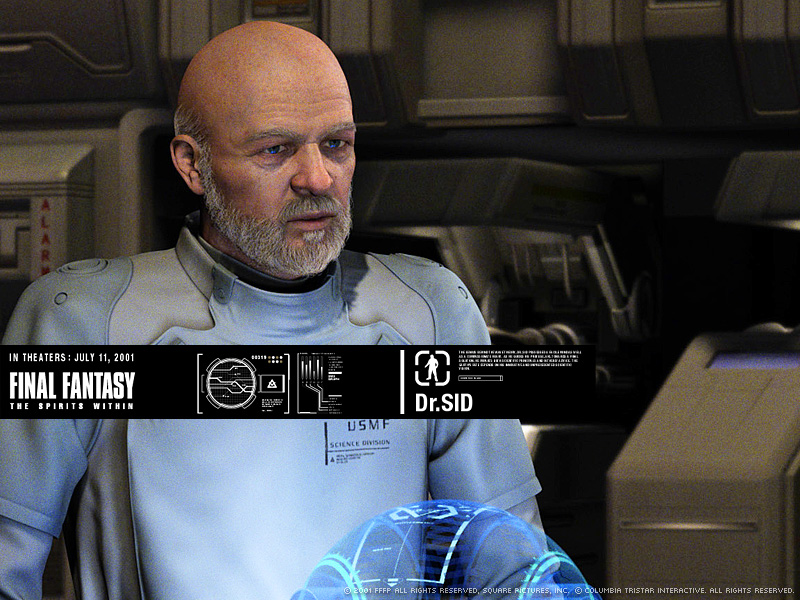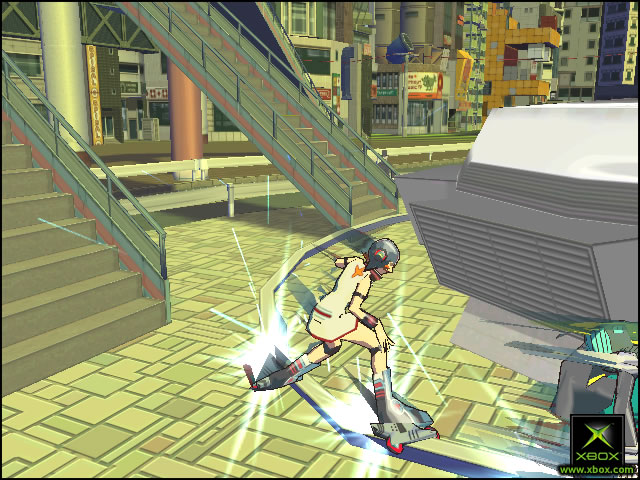|
Los Angeles, CA. 350 people, 6 terabytes of data, and 5 years
of production -- Shrek piled up some impressive numbers. More
impressive, however, was the end result: a 100% computer graphics (CG)
tale of an ogre, a princess, and a donkey with enough personality and
realism to show that PDI/Dream Works has what it takes to make an
animated hit. Two days before the keynote address, the real kickoff
to SIGGRAPH 2001 was the
Shrek
production team's massively attended course about the movie, which
doled
out these impressive numbers and described the science behind the film.
SIGGRAPH is the Association for Computing Machinery's (ACM)
special interest group on graphics, and also the name of its
biggest conference, held this year at the LA
Convention Center. The conference brings together researchers,
hardware vendors, game programmers, artists and the motion picture
industry to discuss the state of science, technology, and art in
computer graphics. The result is matrices, polygons, GeForce3… and
Shrek!
| |

Fluid simulation algorithm used in Shrek. Click
for animation. |
Computer animated films like Shrek
contain a lot of hacks. For example, all lighting is direct
rasterization-- no global illumination is used. This
allows artists to
light
one character and not have extra shadows or light splash on to the
scene, but it means the results aren't as realistic. To attain
realism, effects like the
bright focused caustic underneath a crystal sphere or the glint of sun
off a sword are faked. Also scenes are built and animated as needed;
move the camera a few feet and you'd discover that a character's legs
aren't moving, and maybe don't even exist. Increasingly, however,
major parts aren't hacks. Fluid simulations of mud, water, and beer
in Shrek were based on the real 3D Navier-Stokes equations and
appeared as a scientific paper
by Foster and Fedkiw in the conference proceedings. Instead of moving
facial bones and keypoints for animation like in video games or Toy
Story, the characters of Shrek had a full physiological
model of
facial muscles and skin. Animators actually tensed individual muscles
to make an expression, and an in-house program synchronized lip
movements against vocal tracks. If only the Final Fantasy movie had used the
same system to improve its characters' lackluster lip movements!

Square USA was rendering Dr Sid and Dr Ross in at 20 fps on an
nVidia card.
(image from the movie, not the real-time
animation)
| |
Despite the disappointing facial animation from their movie, Square
Pictures and Square USA swept the other demos away on the trade
exhibition floor at the conference. With nVidia's Quadro board in a
2.0GHz Pentium IV machine, they were rendering a scene from Final
Fantasy: the spirits within... in real time! This incredible
display
used actual animation and dialog from the movie and simplified models.
Using the nVidia card's advanced features, they combined per-pixel
lighting, bump mapping, anisotropic shading, skinning, and depth of
field effects. The demo was running at approximately 30 fps and was
definitely being rendered in real time: you could move the camera and
lights and turn on and off rendering features. nVidia presented
information about implementing similar functionality on the GeForce3
at a real-time shading panel and released new demo code on their website.
| |
Games Panels
Games have steadily increased in visibility at
SIGGRAPH. This year, several panels and talks directly
concerned games. Jennifer Olsen, senior editor at Game Developer Magazine led a panel
in the
exhibitor forum on the need for more game play. Jet Set Radio, Tony
Hawk Pro Skater 2 (Game Boy Advance), and SSX were cited as examples of new games
with great game play. The challenge is incorporating storyline,
multiplayer, and solid arcade game play. Right now these elements are
usually in opposition. The extreme sport games mentioned above all
have game play but laughable storylines. Games like Deus Ex target an immersive experience but
lack the simple drop-in fun of an arcade game, and don't work well as
multiplayer games. Ion Storm promised that in Deus Ex 2 gamers will
see more of the freedom and immersion that made the original so
popular.
George Suhayda (Sony Picture Imageworks), Tom Hershey, Dominic
Mallinson, Janet Murray (Georgia Institute of Technology) and Bill
Swartout participated in another panel on game play entitled "Video
Game Play and Design: Procedural Directions". Their focus was on
leveraging the power of new graphics cards to improve dynamic
storytelling.
A panel called "Masters of the Game" featured presentations by Academy
of the Interactive Arts and Sciences awards winners. These
presentations consisted
of award show style speeches and lacked useful content, but the high
level of attendance showed that SIGGRAPH attendees are interested in
games.
|
Hecker vs. Pfister
The "Computer
Games and Viz [Scientific Visualization]: If you can't beat them, join
them" panel was intended to focus on ways scientists can take
advantages of game technology. It turned into a series of
antagonistic barbs as misunderstandings between the scientific and
gaming communities bubbled to the forefront. Though the debate was
kept good natured and everyone laughed a lot, the undercurrents of
animosity were real.
Hanspeter Pfister, a MERL researcher
well known for his work on volume and surfel rendering, led the charge
against game developers. He characterized developers as Neanderthals
eager for whiz-bang features with no long term vision, and living only
to hack assembly and consume more fill rate. Chris Hecker, editor at
Game Developer Magazine and the Journal of Graphics Tools, was witty and
gracious as he defended game developers from the stereotype while
acknowledging the contributions of scientists to games. Granted,
wearing shoes and getting a haircut might have made Hecker's case for
the maturity of game developers more convincing.
| |

SSX on the PlayStation 2 by Electronic Arts. The lead render
programmer
Mike Rayner shared his experience with rendering and game play on the
title.
|
It was clear that many scientists don't understand what game
developers do and are upset that consumer grade graphics are oriented
towards games and not scientific applications. They are in a tough
place: cheap PC hardware has the power of a workstation, but lacks the
finer appointments. Missing are high (greater than 8 bits per channel)
bit
depths, hardware accumulation buffers, image based rendering
primitives, and high texture bandwidth. PC's are displacing
workstations in many institutions,
driving up workstation prices, yet the PC graphics cards don't really
offer
the feature sets that researchers need.
Scientific visualization is behind MRI's, computer assisted surgery,
military network simulations, and earthquake research. In each of
these situations, a misplaced pixel could be the difference between
life and death. Results need to be correct, fast, and computed
without crashing the machine. When researchers see "features" like
embossed bump
mapping come and go and a new API with each version of DirectX, they think
this is what game developers want and that the technology used for
gaming is too unstable for research.
Hecker and Nate Robins (Avalanche Software) explained that game
developers want many of the same features that researchers want -- just
check John Carmack's
.plan. Higher internal precision, better filtering, better 3D
texture support are at the top of the wish list. As to game
developers using hacks, Hecker replied, "Where do you think we get our
algorithms? We read SIGGRAPH." Bump mapping, Phong illumination,
texture mapping, environment mapping, radiosity and other common game
algorithms all appeared as scientific publications long before they
found their way into Quake. Sophisticated game developers want a
stable, platform independent graphics library. They have
been at the mercy of nVidia, ATI, and Microsoft's feature wars as much
as scientists.
Panel organizer Theresa-Marie Rhyne pointed out that games like
SimCity have actually affected the way urban planning simulation is
done. Other scientists on the panel, Peter Doenges (Evans &
Sutherland) and William Hibbard (University of Wisconsin-Madison) were
respectful of the graphics progress by games developers. Rhyne is no
stranger to the convergence between games and science; she's written
several papers on the topic and is experimenting with game hardware in
her own lab.
In the end, few panel members seemed to change their viewpoint. An
exasperated Chris Hecker was finally driven to object, "scientists need
to stop bitching and moaning." Organizer
Rhyne intended to stir up controversy, promoting these issues to the
forefront,
and got it. Hopefully she'll bring us a re-match next year.
Black Oil
At last
year's art and emerging technology exhibition, a mechanical
display device called the Wooden
Mirror stole the show. This year's coolest techno-art was Minako Takeno and Sachiko Kodama's <Protude,
Flow>. To see the piece, viewers lined up to enter a crowded
black room tucked into the back of the exhibition. Once inside, people
first stared at the writhing spiky shapes back-projected onto a wall.
The shapes moved in response to a re-echoing sountrack of screams and
clicks. Then it became clear that the image was a real-time video feed
from a table in the room. In the middle of the table was a
creation that was pure science fiction. A pool of black oil moved
under its own control, forming independently roving lumps that looked
like a koosh-ball's evil twin. Then they launched upward to a cylinder
suspended over the table, a flow of oil that ran up to pool on
the bottom of the cylinder. Without warning, the oil suddenly
released itself and splashed down to pool and ripple like
normal, inanimate fluid. Mechanical trick? Alien virus? Nope, the
black oil is a ferrofluid, a
suspension of regular oil and magnetic micropowder. A microphone
picked up sounds from the audience and the soundtrack and used them to
drive electromagnets in the table and the floating cylinder. The
ferrofluid moved in response to this field, like the iron filings in a
high school science class. Want one in your living room? Write to info@campuscreate.com… and
don't leave your credit cards on the magnetic table.
Hardware Rendering
Behind the trade show, panels, art exhibition, and courses, comes
the
original purpose of SIGGRAPH: scientific papers. Many of this year's
papers are directly relevant to game development. Ronald Fedkiw, Jos
Stam, and Henrik Wann Jensen's paper "Visual Simulation
of Smoke" used the inviscid Euler equations to simulate realistic
smoke in 2D and 3D. These equations are similar to the Navier-Stokes
equations used for both real fluid flow simulation and demo effects of
rain in a shallow pool. Most physical dynamics approaches suffer from
numerical error that either adds or removes energy from the system
after each simulation step. Adding energy causes simulations to
explode and removing it causes them to deflate. Both kinds of
instability lead to poor results. Fedkiw, Stam, and Jensen's approach
avoids this by allowing the simulation to lose energy, keeping it
stable, then selectively injecting energy back into the vortices.
Because vortices are the most visually important part, this keeps
fine-level detail in the smoke and makes it look realistic. Although
the full 3D version of the algorithm takes 1 second to simulate
movement within a 40x40x40 voxel grid (and render it with self
shadowing!), 2D versions can run fast enough for real-time game
effects. At the end of his talk, Stam held his PocketPC in the air
and rendered 2D smoke reacting to real-time disturbance by his stylus
and received thunderous applause.


Images from A
Real-Time Procedural Shading System for Programmable Graphics
Hardware
|
|
Seven papers on hardware rendering showed that not all scientists are
upset with their GeForce3 cards. The WireGL and Lightning-2 papers
described systems for leveraging armies of PCs to render immense
scenes at interactive rates. Kekoa Proudfoot, William R. Mark,
Svetoslav Tzvetkov, and Pat Hanrahan presented "A
Real-Time Procedural Shading System for Programmable Graphics
Hardware". Their images, shown on the left, look like what we
used to expect to see from ray-tracing, and are rendered in real-time.
Erik Lindholm, Mark J. Kilgard, Henry Moreton's "A User-Programmable
Vertex Engine" paper describes the GeForce3 architecture. Although
the GeForce3 is actually clocked slower than the last-generation
GeForce2 Ultra, it is substantially more powerful because of the
programmable pipeline. With a GeForce3, the programmer can download
code onto the graphics processor for custom transformations of
individual points and per-pixel shading and blending. This allows
effects like per-pixel Phong shading, realistic hair and fur, and
reflective bump mapping...although it does require programmers to work
in a painful custom assembly language. Extensive examples are
available in nVidia's newly released NVSDK
5.1.
|
|
Michael D. McCool, Jason Ang, and Anis Ahmad's "Homomorphic
Factorization of BRDFs for High-Performance Rendering" shows that
high quality shading and real-time can coexist. The Bi-Directional
Reflectance Function, or BRDF, is a four dimensional function that
describes how a surface reflects light based on varying viewer and
light angles. The BRDF has long been
considered the most scientifically accurate measurement of
material lighting properties. It was traditionally used in high end
ray-tracers, but McCool et al. show that clever programming of a
GeForce3 can produce sophisticated light reflection in real-time.
Just in time to raise the bar, Henrik Wann Jensen, Steve Marschner,
Marc Levoy, and Pat Hanrahan introduced a new variation on the BRDF
that accounts for subsurface effects. It can't be rendered in
real-time with current techniques; to illuminate a single point on an
object, all other points must be considered, making the rendering a
time-consuming process. The effects look incredibly realistic,
producing marble and skin that are almost identical to photographs.
| |

New BSSRDF
Technique
|
Emil Praun, Hughes Hoppe, Matthew Webb, and Adam Finkelstein "Real-Time
Hatching" used hardware accelerated textures and shading to
produce hatched line art images of 15k polygon models in real-time.
Randima Fernando, Sebastian Fernandez, Kavita Bala, Donald
P. Greenberg's Adaptive
Shadow Maps fix the biggest problem with the hardware shadowing
support: aliasing. SGI's OpenGL shadow map extension is now
supported by GeForce3 hardware, but unless the camera and light are
pointed in the same direction, ugly rectangular blocks appear in
shadows, making them look like they were rendered on an old Atari.
The new adaptive shadow map fixes this problem by selectively
allocating more resolution to the areas where the blocks would appear.
When implemented directly in hardware, this new method may be the
generic shadow algorithm game developers have longed for.
The full proceedings aren't yet on-line at the ACM (they will appear
in the Digital
Library soon), but some are freely
available from the original authors.
The War in Graphics
The introduction of nVidia's GeForce3
has
put the last nail in SGI hardware's
coffin.
Scientists are dropping expensive workstations in favor of
(relatively) cheap, programmable GeForce cards. Nearly every demo at
SIGGRAPH was run on a GeForce card, and nVidia was all the buzz
despite their subdued showing at the trade show. With the GeForce
hardware in the X-Box, the GeForce2Go laptop graphics card, and the
nForce chipset for cheap GeForce2 graphics directly on a motherboard,
nVidia is poised to seize to take low-end graphics away from ATI this
year. Chris Hecker pointed out that for years, the PC graphics
industry just copied old SGI designs. Recently, they passed SGI and
started innovating on their own. Although early designs littered APIs
with useless special-purpose effects, new PC graphics cards are
showing generality and strong long-term architectural trends.

Jet Set
Radio Future on the X-Box.
| |
The
industry is about to experience an all out war between ATI and nVidia
that may clutter DirectX and OpenGL with more useless marketing-driving
features. But if the new programmable pipelines are any indication,
we'll also see real innovation, and possibly a single
graphics chip manufacturer that will pick up where SGI left off.
The war won't only be on the PC's -- although all sides were silent
at SIGGRAPH, this Christmas Microsoft X-Box, Sony PlayStation2, and Nintendo GameCube will face off. Sony has the
existing market share, but GameCube's bringing world-renowned game
designer Miyamoto the computing power he needs to make Mario and
Metroid the way gamers have always dreamed. With a modified GeForce3
under the hood, Microsoft hopes to take nVidia's winning streak into
the console arena. The market may only be big enough for one to
survive. |
Looking Forward
In a few months, Pixar will release the most ambitious CG movie ever
made. "Monsters, Inc." has billions of polygons in every scene and
features dynamic simulation of the 2.3 million hairs on its
furry hero,Sullivan. The scenes contain so much detail
that Pixar cannot use regular 32-bit integers to index their polygons,
and is rapidly approaching the point where they will spend more time
transferring geometry over their gigabit network to the render-farm
than producing the frames when they get there.
Most of this geometry is well below the pixel level, and a
simplification would look exactly the same at the 1024x768 resolution
at which many games run. If nVidia can stay on their incredible
performance curve for another year, will we see Monsters, Inc. with
fewer polygons rendered in real-time on a Geforce4? How will the new
X-Box Oddworld game look next to
the upcoming Oddworld movie? Even if real-time Monsters, Inc. is just
a fantasy, the buzz about Doom
III and Quake 4 says id
Software is
going to raise the standard for 3D games once again. Doom brought us
first person shooters and network gaming, and turned id from a
shareware company into a multi-million dollar games powerhouse. Quake
made true 3D the standard and established John Carmack as a
programming super-hero. Taking full advantage of nVidia's new
features, the Doom III engine should finally cross the photo-realism
barrier for games and reestablish id software as king of the industry.
With the upcoming battles of the graphics hardware and console titans
and game developers and scientists discovering how to really leverage
the awesome programmable GeForce3, this is sure to be a stellar year
for computer graphics.
| | |

|
High noon in San Antonio, July 23, 2002: showdowns between Chris
Hecker and Hans-peter Pfister; nVidia and ATI; Microsoft, Nintendo,
and Sony; id Software and Epic MegaGames; PDI/Dreamworks, Pixar, and
Square... expect to be blown away at SIGGRAPH 2002!









